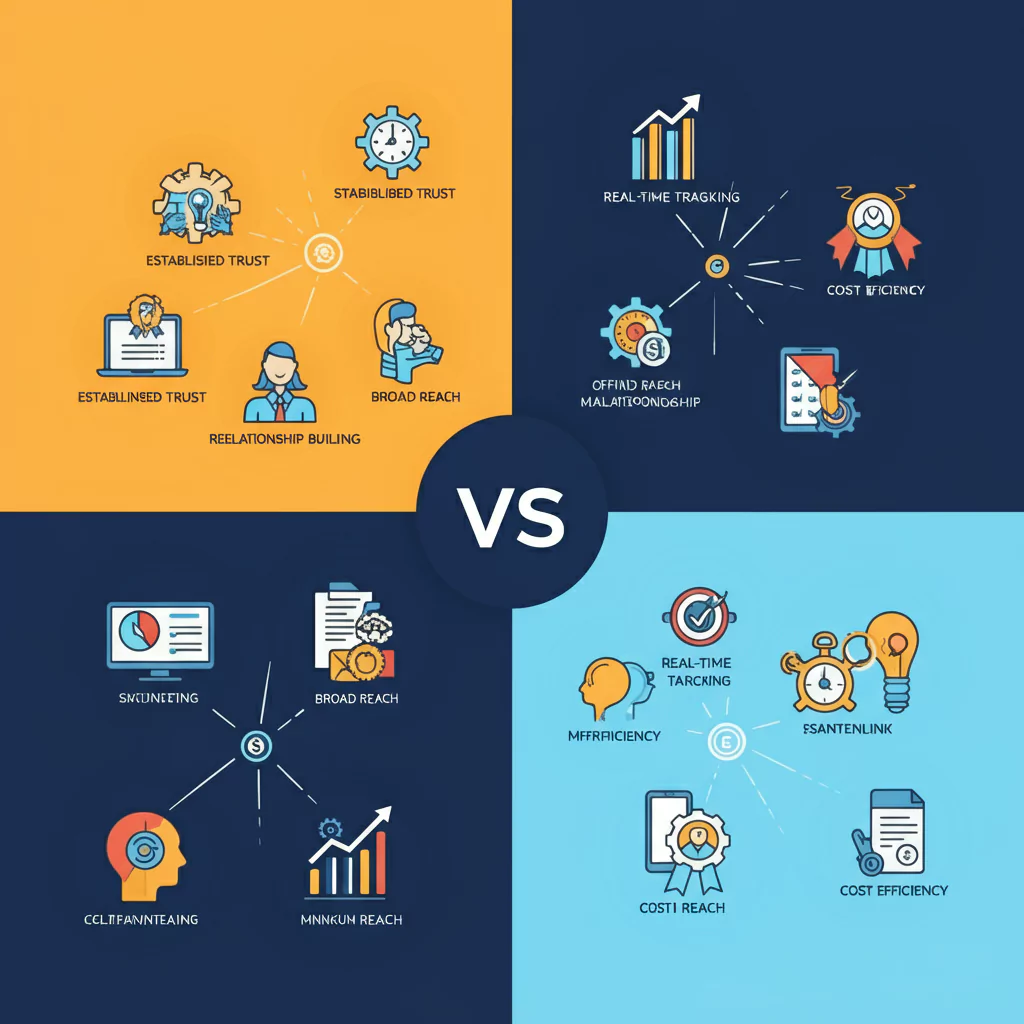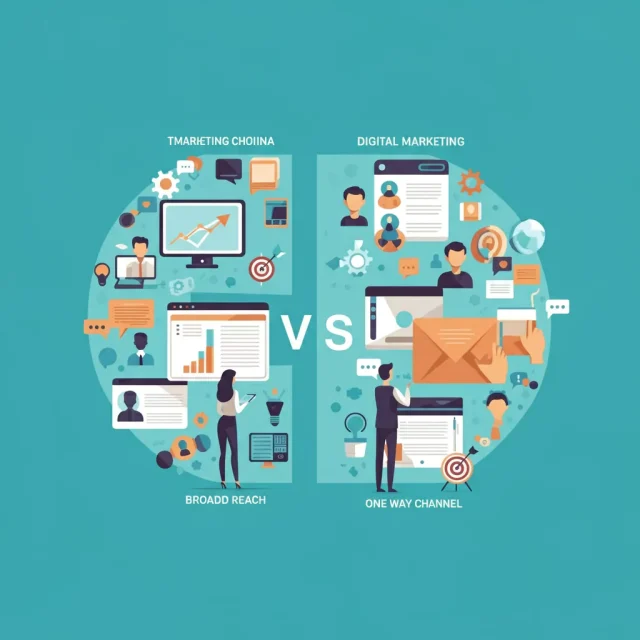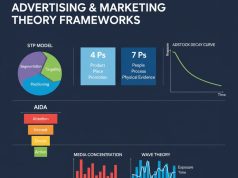The terms “marketing” and “digital marketing” are often used interchangeably, but they represent distinct approaches to reaching customers. While one encompasses a broad range of promotional activities, the other focuses specifically on online channels and digital technologies.
Understanding these differences is crucial for businesses developing their promotional strategies. This post breaks down the key distinctions between marketing and digital marketing, explores their unique characteristics, and helps you determine which approach best serves your business goals.
What is Marketing?
Marketing encompasses all activities designed to promote products, services, or brands to target audiences. This broad discipline includes market research, product development, pricing strategies, distribution planning, and promotional campaigns across various channels.
Core Components of Marketing
Market Research and Analysis
Marketing begins with understanding customer needs, preferences, and behaviors. This research informs product development, pricing decisions, and promotional strategies.
Product Development and Positioning
Marketers work closely with product teams to ensure offerings meet customer needs and stand out from competitors. This includes defining unique value propositions and positioning strategies.
Pricing Strategy
Marketing involves determining optimal pricing structures that balance profitability with customer value perception and competitive positioning.
Distribution Planning
Marketers decide how and where products will be sold, from retail partnerships to direct-to-consumer channels.
Promotion and Communication
This includes advertising, public relations, content creation, and other activities designed to communicate with target audiences.
Traditional Marketing Channels
Marketing traditionally relies on established media channels that have proven effective over decades:
Print Media
Newspapers, magazines, brochures, and flyers provide tangible marketing materials that customers can reference repeatedly.
Broadcast Media
Television and radio advertising reach large audiences simultaneously, making them ideal for brand awareness campaigns.
Outdoor Advertising
Billboards, transit ads, and signage capture attention in high-traffic areas where potential customers spend time.
Direct Mail
Postal mailings deliver targeted messages directly to specific geographic areas or demographic groups.
Event Marketing
Trade shows, conferences, and promotional events create face-to-face interactions with potential customers.
What is Digital Marketing?
Digital marketing refers specifically to promotional activities conducted through digital channels and technologies. This subset of marketing leverages internet-connected devices, online platforms, and digital tools to reach and engage customers.
Core Components of Digital Marketing
Search Engine Optimization (SEO)
SEO involves optimizing website content and structure to improve visibility in search engine results pages.
Pay-Per-Click Advertising (PPC)
PPC campaigns place advertisements on search engines, social media platforms, and other websites, with advertisers paying only when users click their ads.
Social Media Marketing
This includes creating and sharing content on social platforms, engaging with followers, and running paid social media campaigns.
Email campaigns deliver targeted messages directly to subscribers’ inboxes, nurturing relationships and driving conversions.
Content Marketing
Creating valuable, relevant content attracts and engages target audiences while establishing expertise and building trust.
Influencer Marketing
Partnering with influential individuals who have established audiences in specific niches or demographics.
Mobile Marketing
Strategies specifically designed for mobile devices, including app-based advertising and SMS marketing.
Digital Marketing Channels
Digital marketing operates through various online platforms and technologies:
Search Engines
Google, Bing, and other search engines provide opportunities for both organic visibility and paid advertising.
Social Media Platforms
Facebook, Instagram, LinkedIn, Twitter, and emerging platforms offer diverse audiences and advertising options.
Email Platforms
Sophisticated email marketing tools enable automated campaigns, personalization, and detailed analytics.
Websites and Landing Pages
Company websites serve as central hubs for digital marketing activities, while specialized landing pages focus on specific campaigns.
Mobile Applications
Apps provide direct access to customers’ devices, enabling push notifications and in-app advertising.
Key Differences Between Marketing and Digital Marketing
Channel Focus
Marketing encompasses all promotional channels, including both traditional and digital options. A comprehensive marketing strategy might include television advertising, print materials, social media campaigns, and email marketing.
Digital marketing focuses exclusively on online channels and digital technologies. Every digital marketing activity requires internet connectivity or digital devices to reach customers.
Geographic Reach
Marketing can target local, regional, national, or international audiences depending on the chosen channels. A local restaurant might use community newspapers and radio stations, while a national brand might invest in television commercials.
Digital marketing inherently enables global reach. A social media post or search engine advertisement can potentially reach users worldwide, though targeting options allow for geographic restrictions.
Measurement and Analytics
Marketing measurement varies significantly by channel. Traditional marketing relies on surveys, focus groups, and indirect metrics like brand awareness studies or sales correlations.
Digital marketing provides detailed, real-time analytics for every campaign element. Marketers can track impressions, clicks, conversions, and customer journey patterns with precision.
Customer Interaction
Marketing interactions depend on the chosen channels. Traditional marketing typically involves one-way communication, while events and personal selling enable two-way conversations.
Digital marketing emphasizes interactive engagement. Social media comments, email responses, and website behavior create continuous opportunities for customer interaction.
Cost Structure
Marketing costs vary widely based on channel selection. Television advertising requires substantial production and placement budgets, while local print ads might cost just a few hundred dollars.
Digital marketing often provides more flexible spending options. Social media advertising allows daily budget adjustments, and email marketing scales with subscriber lists.
Speed of Implementation
Marketing campaign timelines depend on production requirements and media schedules. Television commercials need weeks or months for production and placement, while print ads require design time and publication deadlines.
Digital marketing enables rapid implementation. Social media posts can be published immediately, email campaigns can launch within hours, and online advertisements can begin running almost instantly.
Advantages of Comprehensive Marketing

Multi-Channel Reach
Comprehensive marketing strategies reach customers across various touchpoints. This multi-channel approach increases the likelihood of connecting with target audiences regardless of their media consumption preferences.
Established Trust and Credibility
Traditional marketing channels benefit from decades of consumer trust. Television commercials, newspaper ads, and radio spots carry inherent credibility that can enhance brand perception.
Diverse Audience Targeting
Different marketing channels attract different demographic groups. Combining traditional and digital approaches ensures broader audience coverage.
Offline Relationship Building
Face-to-face interactions through events, trade shows, and personal selling create strong customer relationships that purely digital strategies cannot replicate.
Advantages of Digital Marketing
Precise Targeting Capabilities
Digital marketing enables highly specific audience targeting based on demographics, interests, behaviors, and past interactions. This precision reduces wasted advertising spend and increases relevance.
Real-Time Performance Tracking
Digital campaigns provide immediate feedback on performance metrics. Marketers can adjust strategies based on real-time data rather than waiting for campaign completion.
Cost Efficiency
Digital marketing often delivers better cost-per-acquisition rates compared to traditional methods. Precise targeting and performance optimization maximize budget effectiveness.
Global Reach Potential
Digital platforms enable small businesses to reach international audiences that would be impossible to access through traditional marketing channels.
Interactive Customer Engagement
Digital marketing creates opportunities for ongoing customer conversations through social media, email, and website interactions.
Challenges of Traditional Marketing
Limited Targeting Precision
Traditional marketing struggles to reach specific customer segments efficiently. Broad demographic targeting often includes many individuals with no interest in the advertised products.
Measurement Difficulties
Attributing sales directly to traditional marketing activities remains challenging. Multiple touchpoints and delayed purchase decisions complicate return-on-investment calculations.
Higher Minimum Investments
Traditional marketing typically requires larger upfront commitments. Television production, print design, and media placement costs can quickly accumulate.
Reduced Flexibility
Traditional marketing campaigns are difficult to modify once launched. Television commercials and print ads cannot be easily adjusted based on performance feedback.
Challenges of Digital Marketing
Information Overload
The abundance of digital marketing messages can overwhelm consumers. Email inboxes fill with promotional content, and social media feeds contain numerous advertisements.
Privacy Concerns
Digital marketing’s data collection practices raise privacy concerns among consumers. Regulations like GDPR and CCPA reflect growing demands for transparency and control.
Rapid Technology Changes
Digital marketing platforms, tools, and best practices evolve constantly. Marketers must continuously learn new technologies and adapt to platform changes.
Competition for Attention
Digital environments feature intense competition for consumer attention. Countless messages compete simultaneously for user engagement.
Integration Strategies
The most effective approach often combines traditional marketing principles with digital marketing execution. This integrated strategy leverages the strengths of both approaches while mitigating their respective weaknesses.
Consistent Messaging Across Channels
Integrated strategies ensure consistent brand messaging across all touchpoints. Customers receive reinforced messages whether they encounter traditional or digital marketing materials.
Cross-Channel Attribution
Digital marketing analytics can provide insights into traditional marketing effectiveness. Website traffic spikes during television commercials, and search volume increases following radio advertisements.
Amplified Reach and Frequency
Traditional marketing can drive awareness that digital marketing then captures and converts. A television commercial might introduce a brand, while targeted digital ads encourage specific actions.
Choosing Your Marketing Approach
Selecting between comprehensive marketing and digital marketing depends on several business-specific factors.
Target Audience Preferences
Consider where your customers spend their time and how they prefer to receive information. Younger demographics might respond better to digital campaigns, while older audiences might prefer traditional media.
Budget Constraints
Evaluate your available marketing budget and required minimum investments. Digital marketing often provides more flexible spending options for smaller businesses.
Business Objectives
Define whether you’re prioritizing brand awareness, lead generation, customer retention, or direct sales. Different objectives may favor different marketing approaches.
Industry Characteristics
Some industries benefit more from traditional marketing approaches, while others thrive with digital strategies. B2B companies might emphasize LinkedIn and email marketing, while consumer brands might focus on social media and influencer partnerships.
Geographic Scope
Local businesses might benefit from traditional marketing channels like local newspapers and radio stations, while businesses targeting national or international markets might prioritize digital strategies.
The Future of Marketing Strategy
Marketing continues evolving as technology advances and consumer behaviors shift. The distinction between marketing and digital marketing becomes less important than creating effective customer experiences across all touchpoints.
Successful marketers will adapt their strategies to leverage new opportunities while maintaining proven approaches that deliver results. The key is understanding that both traditional and digital marketing have unique strengths that can work together to create comprehensive customer engagement strategies.
Consider your business objectives, target audience, and available resources when deciding how to balance traditional and digital marketing approaches. The most effective strategy often combines elements of both, creating multiple touchpoints that guide customers through their journey from awareness to purchase and beyond.
You can learn about: Traditional vs Modern Marketing: Which Strategy Wins?









